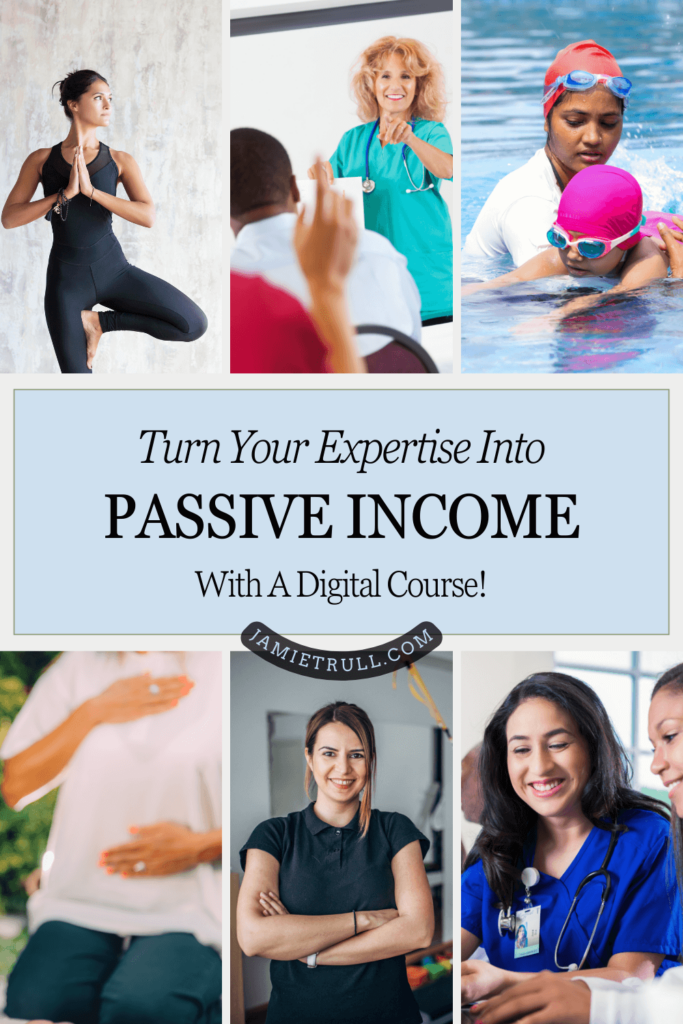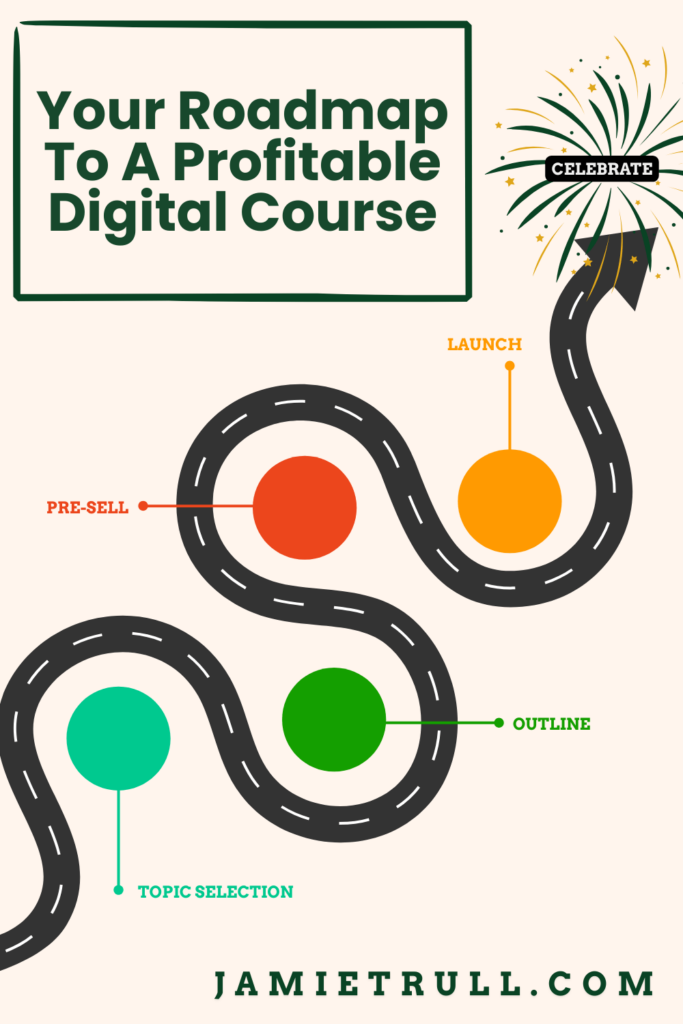
Imagine Creating a Digital Course that Earns Money While You Sleep
Have you ever thought about packaging your knowledge into a digital course that not only impacts others but generates passive income?
Today, we explore the ins and outs of creating a profitable online course with Amy Porterfield, a renowned expert in digital marketing and digital course creation.
Whether you’ve already tried creating a course without success or you’re just brainstorming the idea, this blog will provide essential guidance to launch a course that sells.
This post dives deep into strategies discussed between Jamie Trull and Amy Porterfield, outlining actionable steps to move from idea to launch.
Read on for the step-by-step breakdown and insights on what’s working (and not working) in 2024’s online course market.
1. Step-by-Step Guide to Building a Course that Works

Step 1: Identify Your Course Topic with a “10% Edge”
According to Amy, the first step in course creation is to identify a topic where you have a 10% edge—knowledge or skills that you’ve applied to achieve real results for yourself or someone else.
You don’t need years of university certifications or qualifications—just practical experience that others can benefit from.
Digital Course Example:
Amy shared a story of Kelly, a lawyer, who built a time management course using a system she developed for herself.
She packaged it into a course and earned over $200,000 from her first launch, despite initially doubting whether it would be valuable.
💡 Pro Tip: Think about areas where you’ve solved problems—whether it’s personal productivity, marketing hacks, or financial strategies.
You likely have a few viable topics already.

Step 2: Build an Outline Using AI for Structure
Once you have your course idea, it’s time to outline it.
Amy emphasizes that while tools like ChatGPT can help generate ideas, the real magic comes from adding your personal experience and expertise.
AI should complement your creativity, not replace it.
Amy suggests starting with a simple outline.
- Break the content into modules.
- Map out actionable steps in each module that will help participants achieve their goals.
💡 Pro Tip: Use AI to brainstorm examples or organize your thoughts, but don’t let it replace your authentic teaching style.

Step 3: Pre-sell Your Course Before Fully Creating It
Amy and Jamie both recommend pre-selling your course to validate your idea before investing too much time and money.
How to Sell A Digital Course Before Making It?
Offer a pre-launch discount to the first few buyers. Aim for at least 10 paying participants—this is a solid sign that people are willing to invest in what you’re teaching. If the course doesn’t sell initially, revisit your offer and gather feedback to refine your messaging or content.
Jamie shared that this approach gave her financial flexibility to reduce client work while focusing on her course and even provided seed money for ads.

2. Digital Marketing Strategy: The Secret Sauce to a Successful Launch
Amy emphasizes that creating the course is just half the battle—learning how to market and sell it ( is what truly determines success.
Here are the key steps:
- Launch Strategy: Use tools like webinars or challenges to attract participants and introduce your course. These formats build trust and provide value upfront.
- Create a Launch Calendar: Plan emails and social media strategy so that your posts build excitement before your course opens for enrollment.
- Set Pricing: Start with a pilot price and increase it as you refine and relaunch the course.
💡 Pro Tip: Jamie shared how a last-minute masterclass 50x’d her course sales. Sometimes, a direct approach like a webinar can convert better than ads and emails alone.
3. Lessons from the Field: Mistakes to Avoid and Success Strategies
What Doesn’t Work in 2024
According to Amy, broad, generic courses are no longer effective. Instead of trying to appeal to everyone, focus on specialization.
For example, rather than a general self-improvement course, niche down to topics like “productivity hacks for solopreneurs”.
What Works: Webinars are Still King
Despite changes in technology, webinars remain one of the most effective ways to sell courses.
Amy explains that modern webinars are shorter and more engaging, but they still offer participants immense value and help build trust.
Jamie backed this up with her own experience, noting how a well-executed webinar skyrocketed her sales beyond other promotional methods.
4. Dealing with Self-Doubt and Getting Started
Feeling overwhelmed or doubting if your course will sell?
Amy reminds us that imposter syndrome is normal.
The key to success isn’t perfection—it’s about getting started, even if your first version is imperfect.
“Everyone who has succeeded with digital courses started with the same doubts,” says Amy.
The difference? They took action.
5. Bootcamp Alert: Get Course Confident with Amy Porterfield
Amy offers a Course Confident Bootcamp once a year—an opportunity to learn the basics of course creation from the ground up.
This bootcamp covers everything from choosing your topic to launching your course.
- Sign up here: jamietrull.com/amy
If you’re reading this after the bootcamp has ended, you’ll still find helpful resources at that link, including tips on email list building and course creation strategies.
Your Roadmap to a Profitable Course
Creating and launching a successful online course doesn’t have to be overwhelming.
With Amy’s proven steps—from choosing a topic and pre-selling to marketing and delivering your content—you can launch a course that makes a real impact.
Follow these steps:
- Identify your 10% edge and choose a course topic.
- Use AI tools to brainstorm, but add your personal touch.
- Pre-sell your course to validate demand.
- Focus on marketing and launch strategies like webinars.
- Remember that imperfect action is better than inaction.
No matter where you are on your course-creation journey, just start. There’s room for everyone in the online education space—you just need to find your niche and offer value.
Watch the Full Conversation with Amy Porterfield ⬇️
This transcript has been formatted for readability, with timestamps removed, but all spoken words are preserved.
Introduction: Transforming Expertise into Income
Jamie: Imagine having an online course that not only helps people but also makes you money while you sleep. Well, it is absolutely possible.
Today, we’re diving into how to create an online course that actually sells. Whether you’ve tried before and struggled, or you’re just getting started with the idea, this is for you! And who better to guide us than Amy Porterfield, the queen of digital course creation?
Meet Amy Porterfield: The Queen of Digital Courses
Jamie: Amy is who I learned everything about course creation from, so I love having her here. Amy, say hi to everyone and tell us a little about yourself.
Amy: Hi, everyone! I always describe myself as an ex-corporate girl turned accidental entrepreneur. I help people create and launch digital courses based on their knowledge, know-how, and skills. I’ve been doing this for 15 years and I can’t wait to share my insights with all of you today.
Step-by-Step Approach to Building a Course That Sells
Jamie: I love how you approach things step-by-step. For someone starting out, what are the essential steps to creating a course that actually sells?
Amy: The first thing is to come up with the right topic—one that aligns with your 10% edge. This means choosing something you’ve successfully done, either for yourself or others, and are now ready to teach. You don’t need tons of certifications; what matters is that you’ve gotten real results.
Choosing Your Course Topic: The 10% Edge
Amy: I’ll share a quick story. One of my students, Kelly, was a lawyer who created a unique time-management system for herself. After teaching it one-on-one, she packaged it into a course and made over $200,000. She didn’t need extra qualifications—she just had a system that worked.
Jamie: That’s so true! Everyone reading this: You likely have knowledge someone else needs. To help you brainstorm, I’ve put together a landing page with free resources from Amy—head to jamietrull.com/amy.
Step 2: Building Your Course Outline (AI Can Help!)
Amy: After selecting your topic, the next step is to build an outline. AI tools like ChatGPT can help brainstorm ideas, but remember—you need to infuse your own experiences and insights to make the content truly valuable. Your course needs to reflect you, not just AI-generated material.
Step 3: Pre-sell Your Course to Validate Your Idea
Amy: I always recommend pre-selling your course. Offer it at a discount to an initial group of buyers to validate demand before you invest a ton of time in creating it. If no one buys, it’s okay! Go back, tweak your offer, and try again.
Jamie: Yes! That’s exactly what I did. Pre-selling helped me secure some funds upfront, which gave me the confidence to reduce client work and focus on creating the course.
Step 4: Launching Your Course with a Marketing Plan
Amy: Once you’ve validated your course, it’s time to market it. This is where webinars, challenges, and social media play a huge role. A launch requires some effort, but it’s essential to make your course visible to your audience.
Jamie: Marketing is the part that catches many people off guard. It’s not enough to just create a course—you need a launch strategy that gets people excited.
Step 5: Create and Deliver the Course Week-by-Week
Amy: Instead of building the entire course before launch, I recommend delivering it week-by-week. This way, you can adjust based on feedback as you go. It also prevents the dreaded feeling of “What if I make this whole thing and no one buys it?”
Jamie: I did exactly that! I delivered my course module by module and incorporated student feedback into the next lessons.
When Things Go Wrong: Learning from Jamie’s Lost Voice Story
Jamie: I lost my voice in the middle of delivering my course! I had to ask my students if they wanted an implementation week to catch up. Thankfully, they loved the idea. It taught me that being flexible and responsive is key.
Amy: That’s a great example! You can be scrappy and still succeed. No one expects perfection—especially during your first launch.
What Works in 2024: Specialization and Webinars
Amy: One thing that isn’t working anymore is broad, generic courses. In 2024, specialization is key. Find a niche audience and offer them something specific that solves their problem.
Amy: On the flip side, webinars still work incredibly well, even after all these years. They’ve evolved—people’s attention spans are shorter now, so I teach faster and engage more—but the core principle of delivering value up front still drives sales.
Jamie: I can confirm that! My recent masterclass 50x’d my sales. Webinars are amazing tools to engage your audience and showcase your expertise.
Getting Started: Join Amy’s Course Confident Bootcamp
Amy: If you’re ready to explore course creation, I highly recommend joining my Course Confident Bootcamp. It’s a once-a-year event where we cover everything—from foundational decisions to marketing strategies.
Jamie: Visit jamietrull.com/amy to register. If the bootcamp is already over, don’t worry—there are other valuable resources at that link to help you get started.
Encouragement for Aspiring Course Creators
Amy: If you’re feeling overwhelmed or doubting yourself, know this: The only difference between you and those succeeding with courses is that they got started. They had the same doubts but took action anyway.
Jamie: I couldn’t agree more! Just start—action, even if imperfect, leads to progress.
Conclusion: Your Roadmap to Success with Digital Courses
Creating a course that sells requires more than just knowledge—it takes planning, validation, and effective marketing. Follow these steps:
- Identify your 10% edge and choose a course topic.
- Outline the course using AI as a tool, not a crutch.
- Pre-sell to validate demand and generate early income.
- Launch strategically using webinars or challenges.
- Create content weekly, adjusting based on feedback.
With these insights from Amy Porterfield, you can confidently embark on your course creation journey. Remember: It’s not about perfection; it’s about progress.
Ready to explore even more insider secrets to digital course success with Jamie Trull??
Check out these articles: